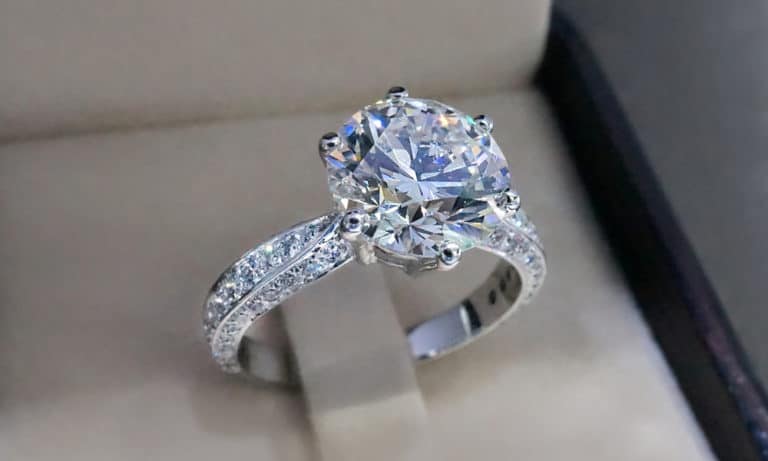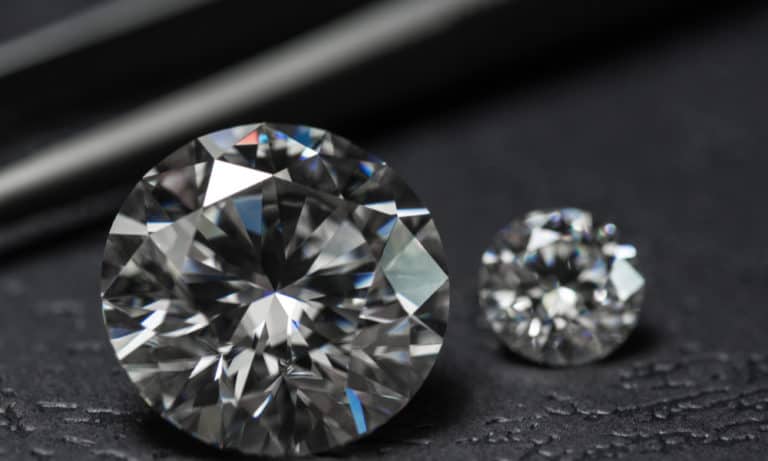
You are probably reading this because you’ve got your eyes set on buying an exquisite ring for your sweetheart. First of all, I must commend you for choosing a 1.5 carat diamond engagement ring.
More often than not, this diamond ring bears a classic symbol of love and commitment. That is why most couples prefer it over a 2 carat diamond ring.
When shopping for a 1.5-carat diamond engagement ring, it’s only natural to ask: How much is a 1.5 carat diamond?
To sum it up, a 1.5 carat diamond can range anywhere between $5,000 (a cheeky Cushion) and $35,000 (a Brilliant Round). And the best value option should cost anywhere between $8,000 and $12,000.
Disclaimer: No one can tell you the exact price of a 1.5 carat diamond since it changes day to day, sometimes hour to hour. The prices mentioned in this page are based on prices we see on 3 leading jewelry stores: James Allen, Blue Nile and Whiteflash.
With that being said, there are a few factors that form the actual price of a 1.5 carat diamond. These include the diamond’s cut, clarity, and color. We’ll look at all those factors (and so much more), but first…
What Is a 1.5 Carat Diamond?

In the jewelry ecosystem, you’ll hear people mention the word carat pretty often. This should not be confused with karat, which is a measure of gold weight or purity.
The carat we’re talking about today is a unit used to measure the diamond weight. If you’ve been following my posts, you know that 1 carat weighs exactly 200 mg (milligrams), 0.2 grams or 0.007 ounces, depending on whichever system you prefer to use.
A carat system can also be divided into points, where a 1 carat diamond equals 1/100 points. You can think of it in terms of pennies. For example, 1 dollar equals 100 pennies.
Speaking of a 1.5 carat diamond, therefore, it lies between 1 carat and 2 carat. As a result, a 1.5 carat diamond weighs 300 milligrams, 0.3 grams, or 0.000661387 pounds. It will also have a total of 150 carat points (150/100).
How Big Is a 1.5 Carat Diamond?

See, there is a reason why most couples prefer a 1.5 carat diamond for engagement ring. This diamond has a diameter of 7.35 mm. This is 0.93 mm bigger than a 1 carat diamond and 0.73 mm smaller than a 2 carat diamond. For a better understanding, check out this 1.5 carat diamond size chart:
| Carat (ct.) | Diameter (mm) | Surface Area (sq. mm) |
| 0.3 | 4.30 | 14.52 |
| 0.4 | 4.73 | 17.59 |
| 0.5 | 5.10 | 20.41 |
| 0.6 | 5.42 | 23.04 |
| 0.7 | 5.70 | 25.53 |
| 0.8 | 5.96 | 27.90 |
| 0.9 | 6.20 | 30.17 |
| 1.0 | 6.42 | 32.37 |
| 1.1 | 6.63 | 34.49 |
| 1.2 | 6.82 | 36.54 |
| 1.3 | 7.01 | 38.54 |
| 1.4 | 7.18 | 40.49 |
| 1.5 | 7.35 | 42.39 |
| 1.6 | 7.51 | 44.25 |
| 1.7 | 7.66 | 46.07 |
| 1.8 | 7.81 | 47.86 |
| 1.9 | 7.95 | 49.61 |
| 2.0 | 8.08 | 51.34 |
Clearly, a 1.5 carat diamond is neither too big nor too small. A diamond of this weight is befitting of any couple who wants a little more than a 1 carat diamond, but may not be in a financial position to acquire a 2 carat diamond.
Besides, a 1.5-carat diamond has a face-up surface of about 42.39, which is approx. 17% smaller than that of a 2-carat diamond. Thus, with everything considered, a 1.5 carat diamond makes for a perfect engagement ring.
It can stand out better depending on two key things: a wearer’s hand and the ring on which it is set. The diamond will look bigger and more prominent if worn in a smaller hand or set on a smaller ring.
Up to this point, I believe you now understand what a 1.5-carat diamond is, and why most couples prefer it over other carat diamonds. We can now proceed and take a look at some of the factors affecting a 1.5 carat diamond’s price.
What Influences a 1.5 Carat Diamond Price?
1. The Cut Factor

You must never sacrifice the diamond cut when shopping for a 1.5 carat diamond. You want a cut that looks sparkly and full of life, not dull and lifeless.
Diamond cut is all about the craftsmanship and proportions of the diamond. It refers to how the diamond is shaped, polished and faceted to maximize brilliance and sparkle.
An excellent (ideal) cut ensures the proportions of the diamond are exact and symmetrical, resulting in the best brilliance, balance and durability. Such a cut tenders a much better illusion of size, thus more expensive.
A poor cut is not as proportional and results in lower brilliance. Such a cut appears to be smaller, thus less expensive. Here’s a table illustrating the surface area of a 1.5 carat diamond across popular cuts:
| Diamond Cut | Surface Area (mm) |
| Asscher | 6.4 x 6.4 (40.96) |
| Heart | 7.5 x 7.5 (56.25) |
| Round | 7.4 x 7.4 (54.76) |
| Princess | 6.3 x 6.3 (39.69) |
| Radiant | 7.2 x 5.8 (41.76) |
| Pear | 10.4 x 6.2 (64.48) |
| Emerald | 7.6 x 5.7 (43.32) |
| Oval | 9.3 x 6.2 (57.66) |
| Marquise | 11.9 x 6 (71.4) |
| Cushion | 6.7 x 6.7 (44.89) |
The diamond’s cut size also has a great effect on its shape. Some shapes appear larger despite having the same carat weight.
For example, asscher and round cuts tend to look the smallest. On the other hand, pear, emerald, oval and marquise cuts are known for appearing larger.
2. The Clarity Factor

This is another significant element when determining the price of a 1.5 carat diamond. The clarity factor shows how much light a stone can reflect without interruptions.
Flaws, blemishes and inclusions prevent a diamond from reflecting as much light. According to the Gemological Institute of America, here’s how a 1.5 carat diamond is ranked from the most expensive to the least expensive:
- Flawless (FL)
- Internally Flawless (IF)
- Very Very Slightly Imperfect (VVSI, VVS2)
- Very Slightly Imperfect (VS1, VS2)
- Slightly Imperfect (S11, SI2)
- Imperfect (I1, I2, 13)
Diamonds with a clarity grade FL are the most flawless diamonds you can get. They’re also the most expensive diamonds out there. For example, a 1.5-carat diamond with an FL clarity grade costs more than $20,000 at James Allen.
Of course, flawed 1.5 carat diamonds tend to look smaller than they should. But then again, you don’t actually need a completely flawless stone for your 1.5 carat diamond engagement ring.
All you need is something that’s transparent and eye-clean. Therefore, we recommend going for VS2 clarity for the best value, eye-clean diamond. You can even go down to SI1 if you want to save more money.
3. The Color Factor

Diamonds come in a range of color grades, from bright tone through to hyaline. Gemstones that have intense colors fall in their own category and have a unique pricing method.
Diamonds used in engagement rings are known to be transparent or colorless. Nevertheless, colorless diamonds may contain several hues that are graded in an alphabetical order, starting with a “D” and ending with a “Z”.
The “D” in this gradation system stands for totally colorless, while the “Z” stands for stones with a significantly yellow tone. A diamond coloring system is divided into three main groups, as follows:
- D, E, and F: The Colorless Grade contains a diamond color that’s rare to find. A D color grade tops the chart, but it’s still difficult to notice the color differences between the diamonds within colorless.
- G, H, I, and J: The Near Colorless Grade diamonds are a perfect choice for a diamond engagement ring. The G color grade tops the category, but most people won’t be able to tell the difference between the colorless grade and the near colorless grade. You can save as much as $1,000 bucks if you choose a near colorless 1.5 carat diamond.
- K, L-Z: This category is made of Faint Yellow Grade and Fancy Color Grade. A K color grade gives your diamond ring a faint yellow tint, which will look just good as a solitaire. Usually, it’ll also look more yellow if it has additional side stones.
In general, fancy color diamonds, like red, are much more valuable as there are only a few in the market. Such diamonds have remarkable light-handling properties that create a better illusion of size.
But there is no need of going for fancy colors if you’re strapped for cash. In fact, there is a very thin line between Zs and Colored diamonds.
For example, the vast majority of people cannot distinguish between a near-colorless G color and a colorless D color diamond because they both seem colorless to the naked eye. But their prices are wide apart.
For instance, while a 1.5 carat D VS1 diamond sells at a whopping $21,000, a 1.5 carat G VS1 diamond costs no more than $12,500. So, even though their price difference is anything but subtle, their looks are almost identical.
For the best bargains, we suggest opting for colorless or transparent diamonds. They’re slightly less expensive than red diamonds. And since they’ve got minimal flaws, they’ll be able to reflect optimum lighting and accentuate the size of your 1.5-carat diamond ring.
Bottom Line
No doubt, a 1.5 carat diamond offers great value for the size as it looks nearly identical to a larger 2 carat diamond. But before you go shopping, make sure you understand all the factors affecting the price of a 1.5 carat diamond. That way, you don’t end up overpaying for features that don’t matter.
To get the best deal on a 1.5 carat diamond, consider shopping at reputable online stores like James Allen, Blue Nile and Whiteflash. We prefer John Allen in particular; because they’ve got a much bigger selection of 1.5 carat diamonds at all price ranges, shapes, and specs.
For example, John Allen’s store boasts over 500 ideal cut 1.5 carat diamonds with H+ color and VS2+ clarity. The best part is, every diamond in their collection is backed with 360-degree HD videos. You’ll be able to spin them around and choose a 1.5-carat diamond that appears eye-clean to your eyes.
Still struggling with finding the best 1.5 carat diamond for your engagement ring? Reach out to us and we’ll be pleased to help you make the right decision.






